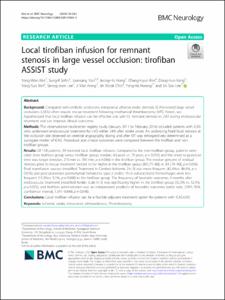Local tirofiban infusion for remnant stenosis in large vessel occlusion: tirofiban ASSIST study
- Alternative Author(s)
- Sohn, Sung Il; Yoo, Joon Sang; Hong, Jeong Ho; Kim, Chang Hyun
- Journal Title
- BMC neurology
- ISSN
- 1471-2377
- Issued Date
- 2020
- Abstract
- Background:
Compared with embolic occlusions, intracranial atherosclerotic stenosis (ICAS)-related large vessel occlusions (LVOs) often require rescue treatment following mechanical thrombectomy (MT). Herein, we hypothesized that local tirofiban infusion can be effective and safe for remnant stenosis in LVO during endovascular treatment and can improve clinical outcomes.
Methods:
This observational multicenter registry study (January 2011 to February 2016) included patients with ICAS who underwent endovascular treatment for LVO within 24 h after stroke onset. An underlying fixed focal stenosis at the occlusion site observed on cerebral angiography during and after MT was retrospectively determined as a surrogate marker of ICAS. Procedural and clinical outcomes were compared between the tirofiban and non-tirofiban groups.
Results:
Of 118 patients, 59 received local tirofiban infusion. Compared to the non-tirofiban group, patients were older (non-tirofiban group versus tirofiban group; median, 63 years vs. 71 years, p = 0.015) and the onset-to-puncture time was longer (median, 275 min vs. 395 min, p = 0.036) in the tirofiban group. The median percent of residual stenosis prior to rescue treatment tended to be higher in the tirofiban group (80 [71–86] vs. 83 [79–90], p = 0.056). Final reperfusion success (modified Treatment In Cerebral Ischemic 2b–3) was more frequent (42.4%vs. 86.4%, p = 0.016) and post-procedure parenchymal hematoma type 2 and/or thick subarachnoid hemorrhages were less frequent (15.3%vs. 5.1%, p = 0.068) in the tirofiban group. The frequency of favorable outcomes 3 months after endovascular treatment (modified Rankin Scale 0–2) was significantly higher in the tirofiban group (32.2% vs. 52.5%, p = 0.025), and tirofiban administration was an independent predictor of favorable outcomes (odds ratio, 2.991; 95% confidence interval, 1.011–8.848; p = 0.048).
Conclusions:
Local tirofiban infusion can be a feasible adjuvant treatment option for patients with ICAS-LVO.
- Publisher
- School of Medicine (의과대학)
- Citation
- Yong-Won Kim et al. (2020). Local tirofiban infusion for remnant stenosis in large vessel occlusion: tirofiban ASSIST study. BMC neurology, 20(1), 284. doi: 10.1186/s12883-020-01864-4
- Type
- Article
- ISSN
- 1471-2377
- Appears in Collections:
- 1. School of Medicine (의과대학) > Dept. of Neurology (신경과학)
1. School of Medicine (의과대학) > Dept. of Neurosurgery (신경외과학)
- 파일 목록
-
-
Download
 oak-2020-0201.pdf
기타 데이터 / 694.87 kB / Adobe PDF
oak-2020-0201.pdf
기타 데이터 / 694.87 kB / Adobe PDF
-
Items in Repository are protected by copyright, with all rights reserved, unless otherwise indicated.